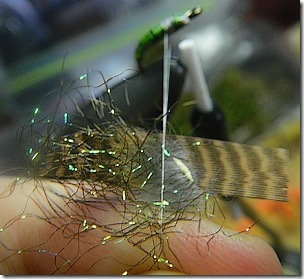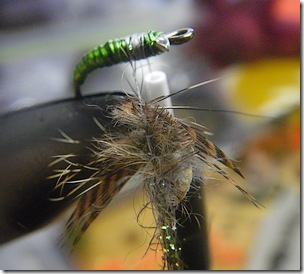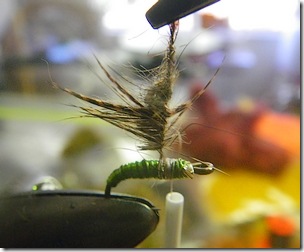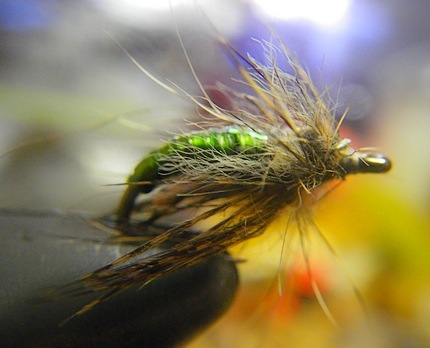I’ve always called it by what it’s good at doing, combining all manner of leftovers into a “chaos wrap”, which tames a gaggle of unruly and dissimilar materials into something cohesive on your hook shank.
As well as melding unrelated objects it can right-size materials that are too long, and add some thread spine into those that are too fragile, as a double strand of thread can add toughness to thin or brittle stems, ensuring that damage is no longer catastrophic and feathers no longer unwind.
It’s also exactly the kind of shaggy I’m looking for when I marry shad’s brightness with trout’s buggy, as unlike the gentle presentation of trout flies, these will be slapped on the water via shooting head and all the G – forces commensurate with a swearing angler and his double haul.
 “Dubbed Loops” have shown a bit of a resurgence of late, and have always worked well converting hair and fur into hackle for big nymphs. Less well documented is their ability to mix a variety of materials into a single strand, and with a judicious stroke of scissors, can offer new opportunities for feathers that are too big for normal attachment and winding.
“Dubbed Loops” have shown a bit of a resurgence of late, and have always worked well converting hair and fur into hackle for big nymphs. Less well documented is their ability to mix a variety of materials into a single strand, and with a judicious stroke of scissors, can offer new opportunities for feathers that are too big for normal attachment and winding.
Above is a tuft of Red Fox Squirrel, dyed teal, and Peacock Angelina that I’ll marry as the thorax of a caddis design. I’ve cast a dubbing loop around the shank and tied it off, and inserted the three materials as a single pinch. I’ll push them collectively up the thread close to the hook shank, then spin them within the loop until the thread tightens around the butts of all three materials.
In the photo above, the material on the left side of the thread will be the portion I’ll retain and wind onto the fly. The material to the right of the thread will be trimmed close to the thread once the thread has started securing it in the loop.
 Resizing materials that are too long for the hook shank is done by pulling only a fraction of the material through to the left side of the loop, just enough to match the length of the legs needed for the fly, trimming the balance when semi-secured.
Resizing materials that are too long for the hook shank is done by pulling only a fraction of the material through to the left side of the loop, just enough to match the length of the legs needed for the fly, trimming the balance when semi-secured.
At right is the loop beginning to spin the materials into a “hackle”. I’ve trimmed all materials on the right side of the thread and will continue spinning the loop until the materials can no longer be pulled from the thread.
 I’ll attempt to persuade the materials to clump on one side with finger pressure or saliva, but as the materials have been spun like a rubber band, they will resist your efforts to tame them.
I’ll attempt to persuade the materials to clump on one side with finger pressure or saliva, but as the materials have been spun like a rubber band, they will resist your efforts to tame them.
Instead I’ll focus on sweeping the material back as it’s wrapped onto the fly. This will minimize the amount of trapped fibers, as well as encourage the strands to sweep over the rear of the fly.
Touching up the thorax area with a bit of Velcro will add a hint of fuzzy free trapped materials and assist them to meld into a cohesive collar as they sweep towards the tail.
Depending on the fly being tied, the distribution of fibers can be made to make either a symmetrical or asymmetrical hackle. Placing the fibers in a clump will yield the small amount of duck under the bug as shown below. Spreading the fibers out yield a traditional style hackle.

The completed experimental. The transparent vinyl is wrapped over a base of flat gold tinsel, affording the abdomen a bit of “pop” and brightness. I’ve tied additional flies in pink and red just to see how traditional Shad colors fish with this caddis-style exterior.


..”.Use those pesky Butt Ends! The next Martha!”
Sorry,SWMBO has her on in the other room…
Nice. Lot’s of potential for this technique. I’m assuming this will work with sections of other feathers as well?
@Rex – it will work with any hair/fur and fiber long enough to be inserted into the loop. You can distribute fibers or leave them all in one spot.
If you use it to “shorten” feathers like partridge or duck, often a good tacky wax can assist in gripping the materials better.
Pure guard hair is quite slippery in comparison to fur, it has to be spun a bit more to hold tightly, sometimes requiring a larger thread to take that strain.
Experiment, you’ll find you can turn anything into hackle, with toughness a second benefit.
Tell us more about the vinyl you are using. Sounds like a new material find.
It’s model airplane vinyl – the kind used to stretch over the balsa thwarts (or aircraft frame) on radio-controlled models.
Look at all the options:
http://www.monokote.com/